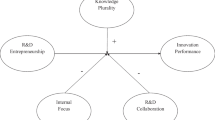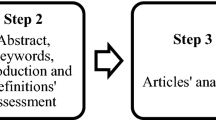Abstract
This study investigates the relationship between characteristics of the firm’s top management team (TMT) and its research and development (R&D) activities. Specifically, this research analyzes how observable characteristics of the TMT, such as functional experiences or educational background, and average tenure affect the firm’s proportion of explorative R&D activities. From the perspective of the upper-echelon theory, we hypothesize that the TMT’s functional experiences with R&D or science or engineering educational backgrounds increase the firm’s tendency towards explorative R&D. Moreover, we propose that the average tenure of TMT members with innovation-related experiences would have a positive moderation effects on these relationships. The hypotheses are tested using a dataset containing biographical information of the TMT members, financial, and patent data of 89 firms in U.S. high-tech industries from 2006 to 2009. Firm’s explorative R&D activities are analyzed using data on patent citations, patent classes, and non-patent references. The empirical analysis shows that the top managers’ educational background in science or engineering as well as their previous functional experiences with R&D have a positive effect on the firm’s explorative innovation activities. We also find that the size of these effects increases with a longer tenure of these TMT members. Our findings provide implications related to the effects of organizational characteristics on the establishment of a R&D strategy and highlight the role of TMT members with innovative experiences in directing a firm’s R&D activities and outcomes.



Similar content being viewed by others
References
Ahuja, G., & Lampert, C. M. (2001). Entrepreneurship in the large corporation: A longitudinal study of how established firms create breakthrough inventions. Strategic Management Journal, 22(6–7), 521–543.
Alexiev, A. S., Jansen, J. J. P., Van den Bosch, F. A. J., & Volberda, H. W. (2010). Top management team advice seeking and exploratory innovation: The moderating role of TMT heterogeneity. Journal of Management Studies, 47(7), 1343–1364.
Bantel, K. A., & Jackson, S. E. (1989). Top management and innovations in banking: Does the composition of the top team make a difference? Strategic Management Journal, 10(S1), 107–124.
Barker, V. L., III, & Mueller, G. C. (2002). CEO characteristics and firm R&D spending. Management Science, 48(6), 782–801.
Baron, R. M., & Kenny, D. A. (1986). The moderator–mediator variable distinction in social psychological research: Conceptual, strategic, and statistical considerations. Journal of Personality and Social Psychology, 51(6), 1173–1182.
Belderbos, R., Faems, D., Leten, B., & Looy, B. Van. (2010). Technological activities and their impact on the financial performance of the firm: Exploitation and exploration within and between firms. Journal of Product Innovation Management, 27(6), 869–882.
Benner, M. J., & Tushman, M. L. (2003). Exploitation, exploration, and process management: The productivity dilemma revisited. Academy of Management Review, 28(2), 238–256.
Callaert, J., Grouwels, J., & Van Looy, B. (2012). Delineating the scientific footprint in technology: Identifying scientific publications within non-patent references. Scientometrics, 91(2), 383–398.
Callaert, J., Pellens, M., & Van Looy, B. (2014). Sources of inspiration? Making sense of scientific references in patents. Scientometrics, 98(3), 1617–1629.
Callaert, J., Van Looy, B., Verbeek, A., Debackere, K., & Thijs, B. (2006). Traces of prior art: An analysis of non-patent references found in patent documents. Scientometrics, 69(1), 3–20.
Carlsson, G., & Karlsson, K. (1970). Age, cohorts and the generation of generations. American Sociological Review, 35(4), 710–718.
Chen, H. L., Hsu, W. T., & Huang, Y. S. (2010). Top management team characteristics, R&D investment and capital structure in the IT industry. Small Business Economics, 35(3), 319–333.
D’Aveni, R. (1994). Hypercompetition: Managing the dynamics of strategic maneuvering. New York: Free Press.
Daellenbach, U. S., McCarthy, A. M., & Schoenecker, T. S. (1999). Commitment to innovation: The impact of top management team characteristics. R&D Management, 29(3), 199–208.
Dearborn, D. C., & Simon, H. A. (1958). Selective perception: A note on the departmental identifications of executives. Sociometry, 21(2), 140–144.
Del Monte, A., & Papagni, E. (2003). R&D and the growth of firms: Empirical analysis of a panel of Italian firms. Research Policy, 32(6), 1003–1014.
Ding, W. W. (2011). The impact of founders’ professional-education background on the adoption of open science by for-profit biotechnology firms. Management Science, 57(2), 257–273.
Finkelstein, S. (1992). Power in top management teams: Dimensions, measurement, and validation. Academy of Management Journal, 35(3), 505–538.
Finkelstein, S., & Hambrick, D. C. (1996). Strategic leadership: Top executives and their effects on organizations. Mason: South-Western Pub.
Fleming, L., & Sorenson, O. (2004). Science as a map in technological search. Strategic Management Journal, 25(8–9), 909–928.
Garcia, R., Calantone, R., & Levine, R. (2003). The role of knowledge in resource allocation to exploration versus exploitation in technologically oriented organizations. Decision Sciences, 34(2), 323–349.
Geiger, S. W., & Makri, M. (2006). Exploration and exploitation innovation processes: The role of organizational slack in R&D intensive firms. Journal of High Technology Management Research, 17(1), 97–108.
Gibbons, M., & Johnston, R. (1974). The roles of science in technological innovation. Research Policy, 3(3), 220–242.
Gittelman, M., & Kogut, B. (2003). Does good science lead to valuable knowledge? Biotechnology firms and the evolutionary logic of citation patterns. Management Science, 49(4), 366–382.
Greve, H. R. (2007). Exploration and exploitation in product innovation. Industrial and Corporate Change, 16(5), 945–975.
Gupta, A. K., Smith, K. G., & Shalley, C. E. (2006). The interplay between exploration and exploitation. Academy of Management Journal, 49(4), 693–706.
Hambrick, D. C. (2007). Upper echelons theory: An update. Academy of Management Review, 32(2), 334–343.
Hambrick, D. C., Cho, T. S., & Chen, M. J. (1996). The influence of top management team heterogeneity on firms’ competitive moves. Administrative Science Quarterly, 41(4), 659–684.
Hambrick, D. C., & Mason, P. A. (1984). Upper echelons: The organization as a reflection of its top managers. Academy of Management Review, 9(2), 193–206.
Hannan, M. T., & Freeman, J. (1984). Structural inertia and organizational change. American Sociological Review, 49(2), 149–164.
He, Z. L., & Wong, P. K. (2004). Exploration vs. exploitation: An empirical test of the ambidexterity hypothesis. Organization Science, 15(4), 481–494.
Heavey, C., & Simsek, Z. (2013). Top management compositional effects on corporate entrepreneurship: The moderating role of perceived technological uncertainty. Journal of Product Innovation Management, 30(5), 837–855.
Hitt, M. A., & Tyler, B. B. (1991). Strategic decision models: Integrating different perspectives. Strategic Management Journal, 12(5), 327–351.
Katila, R. (2002). New product search over time: Past ideas in their prime? Academy of Management Journal, 45(5), 995–1010.
Katila, R., & Ahuja, G. (2002). Something old, something new: A longitudinal study of search behavior and new product introduction. Academy of Management Journal, 45(6), 1183–1194.
Kim, J., Lee, C. Y., & Cho, Y. (2016). Technological diversification, core-technology competence, and firm growth. Research Policy, 45(1), 113–124.
Kor, Y. Y. (2003). Experience-based top management team competence and sustained growth. Organization Science, 14(6), 707–719.
Kor, Y. Y. (2006). Direct and interaction effects of top management team and board compositions on R&D investment strategy. Strategic Management Journal, 27(11), 1081–1099.
Lee, C., Park, G., & Kang, J. (2016). The impact of convergence between science and technology on innovation. Journal of Technology Transfer. doi:10.1007/s10961-016-9480-9.
Levitt, B., & March, J. G. (1988). Organizational learning. Annual Review of Sociology, 14, 319–340.
Li, C.-R., Lin, C.-J., & Huang, H.-C. (2014). Top management team social capital, exploration-based innovation, and exploitation-based innovation in SMEs. Technology Analysis & Strategic Management, 26(1), 69–85.
Li, Y., Vanhaverbeke, W., & Schoenmakers, W. (2008). Exploration and exploitation in innovation: Reframing the interpretation. Creativity and Innovation Management, 17(2), 107–126.
Makri, M., Hitt, M. A., & Lane, P. J. (2010). Complementary technologies, knowledge relatedness, and invention outcomes in high technology mergers and acquisitions. Strategic Management Journal, 31(6), 602–628.
March, J. G. (1988). Variable risk preferences and adaptive aspirations. Journal of Economic Behavior & Organization, 9(1), 5–24.
March, J. G. (1991). Exploration and exploitation in organizational learning. Organization Science, 2(1), 71–87.
March, J. G., & Shapira, Z. (1987). Managerial perspectives on risk and risk taking. Management Science, 33(11), 1404–1418.
Mudambi, R., & Swift, T. (2014). Knowing when to leap: Transitioning between exploitative and explorative R&D. Strategic Management Journal, 35(1), 126–145.
Narin, F., & Olivastro, D. (1992). Status report: Linkage between technology and science. Research Policy, 21(3), 237–249.
Phelps, C. C. (2010). A longitudinal study of the influence of alliance network structure and composition on firm exploratory innovation. Academy of Management Journal, 53(4), 890–913.
Piao, M. (2010). Thriving in the new: Implication of exploration on organizational longevity. Journal of Management, 36(6), 1529–1554.
Priem, R. L. (1990). Top management team group factors, consensus, and firm performance. Strategic Management Journal, 11(6), 469–478.
Qian, C., Cao, Q., & Takeuchi, R. (2013). Top management team functional diversity and organizational innovation in China: The moderating effects of environment. Strategic Management Journal, 34(1), 110–120.
Rosenberg, N. (1990). Why do firms do basic research (with their own money)? Research Policy, 19(2), 165–174.
Rothaermel, F. T., & Alexandre, M. T. (2009). Ambidexterity in technology sourcing: The moderating role of absorptive capacity. Organization Science, 20(4), 759–780.
Schumpeter, J. A. (1942). Capitalism: Socialism, and democracy. New York and London: Harper & Brothers Publishers.
Shirabe, M. (2014). Identifying SCI covered publications within non-patent references in U.S. utility patents. Scientometrics, 101(2), 999–1014.
Stuart, T. E., & Podolny, J. M. (1996). Local search and the evolution of technological capabilities. Strategic Management Journal, 17(S1), 21–38.
Subramanian, A. M., & Soh, P. H. (2010). An empirical examination of the science-technology relationship in the biotechnology industry. Journal of Engineering and Technology Management, 27(3–4), 160–171.
Tabak, F., & Barr, S. H. (1999). Propensity to adopt technological innovations: The impact of personal characteristics and organizational context. Journal of Engineering and Technology Management, 16(3), 247–270.
Talke, K., Salomo, S., & Rost, K. (2010). How top management team diversity affects innovativeness and performance via the strategic choice to focus on innovation fields. Research Policy, 39(7), 907–918.
Trajtenberg, M., Henderson, R., & Jaffe, A. (1997). University versus corporate patents: A window on the basicness of invention. Economics of Innovation and New Technology, 5(1), 19–50.
Tyler, B. B., & Steensma, H. K. (1998). The effects of executives’ experiences and perceptions on their assessment of potential technological alliances. Strategic Management Journal, 19(10), 939–965.
Uotila, J., Maula, M., Keil, T., & Zahra, S. A. (2009). Exploration, exploitation, and financial performance: Analysis of S&P 500 corporations. Strategic Management Journal, 30(2), 221–231.
Vagnani, G. (2015). Exploration and long-run organizational performance: The moderating role of technological interdependence. Journal of Management, 41(6), 1651–1676.
Van Vianen, B. G., Moed, H. F., & van Raan, A. F. J. (1990). An exploration of the science base of recent technology. Research Policy, 19(1), 61–81.
Verbeek, A., Debackere, K., Luwel, M., Andries, P., Zimmermann, E., & Deleus, F. (2002). Linking science to technology: Using bibliographic references in patents to build linkage schemes. Scientometrics, 54(3), 399–420.
Vroom, V. H., & Pahl, B. (1971). Relationship between age and risk taking among managers. Journal of Applied Psychology, 55(5), 399–405.
West, J., & Iansiti, M. (2003). Experience, experimentation, and the accumulation of knowledge: The evolution of R&D in the semiconductor industry. Research Policy, 32(5), 809–825.
Wiersema, M. F., & Bantel, K. A. (1992). Top management team demography and corporate strategic change. Academy of Management Journal, 35(1), 91–121.
Acknowledgements
The Institute of Engineering Research at Seoul National University provided research facilities for the duration of this research.
Author information
Authors and Affiliations
Corresponding author
Rights and permissions
About this article
Cite this article
Lee, C., Park, G., Marhold, K. et al. Top management team’s innovation-related characteristics and the firm’s explorative R&D: an analysis based on patent data. Scientometrics 111, 639–663 (2017). https://doi.org/10.1007/s11192-017-2322-1
Received:
Published:
Issue Date:
DOI: https://doi.org/10.1007/s11192-017-2322-1




